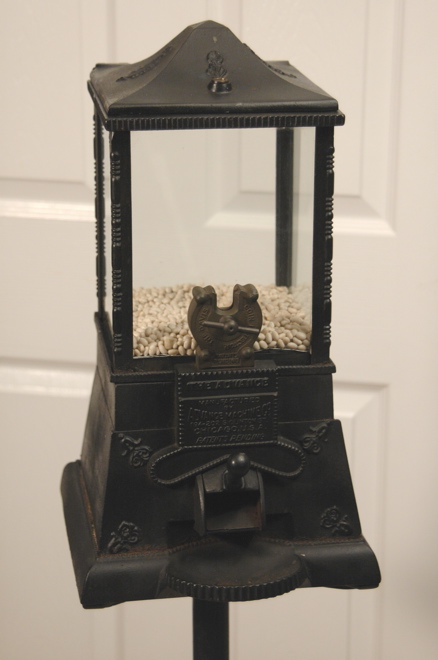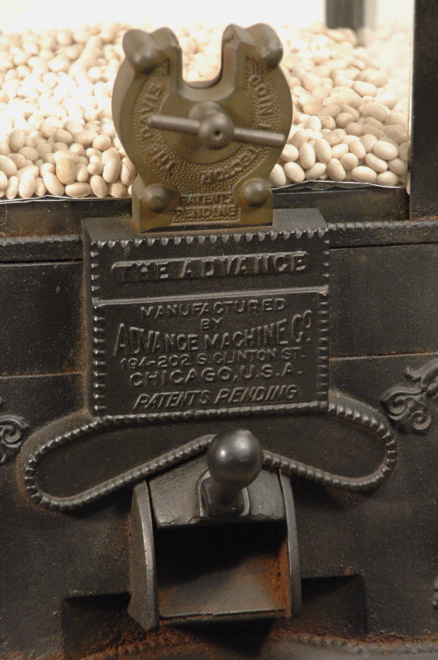___________________________________________________________________________________________
"The Advance" Peanut Machine



___________________________________________________________________________________________



Advance Machine Company, Chicago, IL, c. 1900, 17 1/2" (machine only), 49" (machine plus stand). According to Silent Salesmen Too, the Advance Machine Company was incorporated on September 30, 1900, and came out with this model---their first of many---right after that. The patent date cited in Silent Salesmen Too is October 23, 1900.
To the best of my knowledge this example is one of only four known to still exist. Of those four, two are this version and two are a different version with a turn handle on the front like the one pictured on page 8 of Silent Salesmen Too. The one shown above is the only one of the four with original paint---more about that below---or with a dedicated stand. As far as I can tell it's made completely of cast iron, with a lid that's hinged in back and locks in front. "THE ADVANCE" is embossed into the front plate of the machine just below the slug rejector, and the one pictured in Silent Salesmen Too does not have that. I take that to be the name Advance gave to the model. I'd think it would also be on the other examples--and maybe it's on the two not shown above or in the book--but it's obvious that some major retooling was done between the versions. I don't understand how or why machines that are so rare today could have had variations, except that rarity today doesn't mean that hundreds or even thousands didn't exist at some point (the Northwestern Peanut Merchandiser and the York are two examples I know of that were once plentiful and are now quite scarce). Had Mr. Enes had this available as an example instead of the one he showed in the book, I'd bet dollars to donuts that this would be listed as "The Advance" in Silent Salesmen Too and not just as a generic "Peanut Machine." Collectors call this model "The Advance Peanut Machine" but might have then called it "The Advance....no, I mean the Advance" thus giving it the regal status it deserves.
You insert a penny into the slug rejector, turn the handle on the slug rejector to drop the penny into the coin slot of the machine's body, and then you push down the handle attached to the gate. As the gate lowers, a trap door slides open on the bottom of the vending compartment so that product can fall into the chute when the gate is closed. Release the gate's handle, and the product falls into your hand as the gate rises. That is, that happens if your hand is there to catch it---if it isn't then the product falls to the floor but you'd probably make that mistake only once.
I got this exactly as you see it, but dirtier and stiffer. The seller didn't know what he had until I told him, and he'd been trying to figure out how to get the machine off the stand, and how to loosen a sticky gate, and God knows what else. I said DON'T DO ANYTHING---don't remove the stand, don't unstick the gate, don't clean it, don't touch it up, don't even look at it---until we talk. He listened, and I got this as one big piece in an even bigger box as you can see here. He did a great job packing it, and it arrived unscathed. There's a long and interesting story attached to this acquisition, and I probably won't post it here but you can ask me about it sometime if you're interested and see me when we have time to talk.
This piece appears to be 100% original. If the paint isn't original then it's an ancient repaint, but I'm almost certain it's original. Either way it's in great condition. The coin door on the side is stuck in place---probably because of some rusting around its edges inside the coin compartment---and may never be able to be opened. I took it to my favorite local locksmith and they tried, but if the coin door is rusted shut they can't tell when the lock is open or closed, so couldn't judge the success of their lockpicking efforts. When I first got this machine the gate was gummed up and hard to move, so I sprayed WD-40 into the machine's innards through the chute, and then over the next few days gently worked the gate loose. Then I ran a penny through, and to my horror the machine jammed while the gate was down! I was sooooo bummed because I couldn't get to the mechanism through the coin door and I didn't know how else to unjam it. I moped around for a few days, and then went into the basement where the machine was to see if I could figure out what to do, and the gate was up and moving freely again. It had healed itself! That's the last penny I ran through the machine, and it's the last one I ever plan to run through it. I'm pretty sure the machine works, but won't risk another jam when I'd be powerless (again) to rectify that sad situation.
___________________________________________________________________________________________
___________________________________________________________________________________________
©Small Vintage Vending 2021